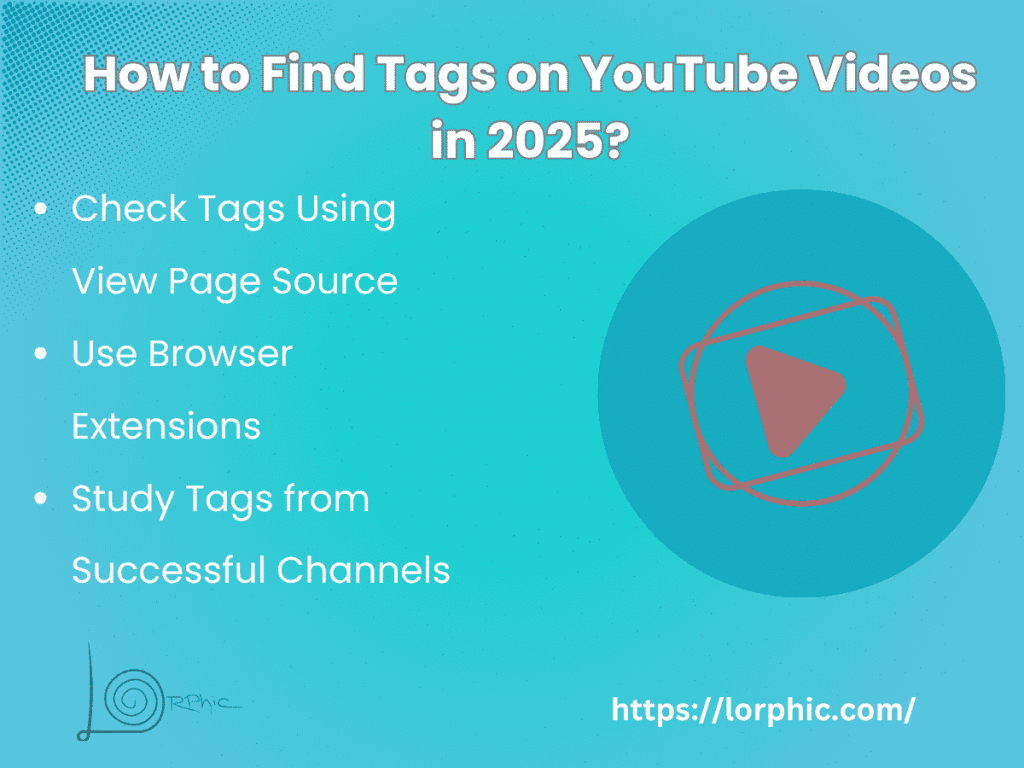If you’re serious about growing your YouTube channel in 2025, understanding how to find tags on YouTube videos is one of those small but powerful skills that can make a big difference.
Tags aren’t the top ranking signal anymore, YouTube’s algorithm is based on watch time, engagement, and search intent these days, but they do contribute to making YouTube aware of your content’s context. And for SEO optimization on YouTube, examining and researching tags from popular videos provides you with useful information about what’s effective in your niche.
In this step-by-step guide, we’ll walk through why tags still matter in 2025, how to find them, the best tools to use, and how to apply your findings strategically for better YouTube SEO results.
Why Finding Tags Matters in 2025?
Many creators believe that YouTube tags no longer hold importance, but that’s only partially true. While YouTube’s algorithm now focuses more on engagement, audience retention, and click-through rates, tags still play a helpful role in improving your video’s discoverability and keyword relevance. According to Google Support, tags can still help YouTube understand your video’s context and make it more discoverable in specific cases.
Here’s why learning how to find and analyze tags still matters in 2025:
1. Understand What’s Working in Your Niche
Exploring the tags used by successful creators in your niche can give you insight into what keywords or topics connect best with your audience. This helps you refine your own YouTube content strategy and make better data-driven decisions when planning future videos.
2. Optimize Your Video Metadata
Tags are an essential part of your YouTube SEO checklist, working alongside your title, description, and thumbnail. Understanding how top creators use tags can help you structure your own metadata more effectively for better visibility.
3. Improve Search and Suggested Rankings
While tags are not the main ranking factor, they still assist YouTube’s algorithm in categorizing your content. When your title and description include similar keywords, tags can strengthen that connection and help your video appear in more relevant searches.
4. Support for Misspelled or Related Terms
Tags also help capture common spelling variations or related keywords. This ensures that even if viewers mistype a search term, your video can still show up in their results, increasing your chances of discovery.
How to Find Tags on YouTube Videos in 2025? Step-by-Step
YouTube no longer shows tags publicly under videos, which means you cannot simply scroll down to view them anymore. However, there are still easy ways to find the tags that creators use. You just need the right steps and tools. Here is a simple guide to help you discover YouTube tags in 2025.

Step 1: Check Tags Using View Page Source
This method can be done directly from your browser without using any special tools.
- Open the YouTube video you want to check.
- Right click anywhere on the video page and select View Page Source.
- Once the page code opens, press Ctrl and F on Windows or Command and F on Mac, then type keywords in the search box.
- You will see a list of words or phrases next to the word “keywords.” These are the tags that the creator added to the video.
This method helps you find which keywords were used to help YouTube understand the video topic.
Step 2: Use Browser Extensions
If you want a quicker way to find tags, browser extensions can do the work for you. These tools show video tags and other details right on the video page. Some popular options include:
- VidIQ which provides keyword insights, tag lists, and video performance data.
- TubeBuddy which offers tag ideas, competitor analysis, and SEO tips.
- Keywords Everywhere which shows related keyword trends and search volume for YouTube.
These tools work with browsers like Chrome and Firefox and display tags directly below the video after installation.
Step 3: Study Tags from Successful Channels
Visit a few popular channels in your niche and check their best performing videos using the same method. Note which tags appear often, compare them across videos, and identify the ones that seem most relevant to your content.
This process helps you understand what works well for others and gives you ideas for your own tag strategy. Over time, using relevant and well researched tags can improve your visibility and help YouTube recommend your videos to a larger audience.
By following these steps, you can easily find YouTube tags in 2025 and use them to strengthen your video SEO and reach more viewers.
How to Use What You Find? Strategic Tag Research
Once you have discovered tags from high-performing YouTube videos, the next step is learning how to use them effectively. Tags are only valuable when applied strategically and with the right purpose. Here is how you can make the most of your research in 2025.
1. Focus on Relevance Instead of Quantity
YouTube’s algorithm has become much more advanced and can easily recognize irrelevant or spammy tags. Adding too many unrelated keywords can hurt your video’s visibility instead of helping it. Concentrate on using a small number of tags that are directly connected to your content and niche. The goal is to help YouTube understand your topic clearly.
2. Combine Tags with Optimized Titles and Descriptions
Tags alone cannot boost your ranking if your title or description is not optimized. Use the tags you have found as inspiration when creating your video’s title and description. For example, if one of your discovered tags is a YouTube SEO tutorial, you could create a title such as Complete YouTube SEO Tutorial for Beginners 2025 Guide.
This consistency between your title, description, and tags strengthens your YouTube SEO and helps your content appear in both YouTube and Google search results.
3. Organize Tags into Groups
To make your SEO more structured, organize your tags into categories based on intent. For instance:
- Main Keyword Tags: YouTube SEO, video optimization.
- Supporting Tags: YouTube ranking tips, find tags on YouTube videos.
- Niche-specific Tags: content creator tips, YouTube growth 2025.
Creating these groups keeps your content well-organized and helps YouTube better understand how your video fits into specific topics. It also ensures a balanced use of tags that support your overall search and discovery strategy.
By applying your tag research strategically, you can improve your video performance, increase visibility, and strengthen your overall YouTube SEO in 2025.
Bonus Tips for 2025 Tag Research
As YouTube’s optimization methods continue to evolve, your tag strategy should grow along with it. Here are some helpful bonus tips to make your tag research more effective in 2025:
- Start by using AI-powered tools such as TubeBuddy’s tag suggestions or VidIQ’s AI Keyword Generator. These tools make it easier to spot trending topics and uncover keywords that can boost your video visibility.
- Keep an eye on your tag performance through YouTube Studio analytics. This section provides insights into which tags are driving the most views and engagement, helping you refine your tagging approach over time.
- When adding tags, focus on long-tail keywords that mirror natural search queries. For example, instead of using a short tag like “YouTube keywords,” try something more specific such as “how to find keywords for YouTube in 2025.”
- Lastly, make it a habit to update your tags regularly. Since search trends change quickly, reviewing and refreshing your tags every few months ensures that your content stays optimized and aligned with current audience interests.
Conclusion
In 2025, finding the right tags for your YouTube videos is not about simply copying what other creators are doing. It is about understanding the strategy behind successful videos and using that knowledge to improve your own. Tags help YouTube understand your content better, which increases the chances of it reaching the right audience.
When you combine smart tag research with a complete YouTube SEO plan that includes keyword-focused titles, engaging thumbnails, and clear video descriptions, your videos become more visible in both YouTube and Google search results. This approach helps your channel grow naturally over time.
It is also important to stay consistent and keep testing new tags as trends change. Regularly reviewing your analytics can show which tags bring in the most traffic and which ones need to be updated.
So, if you are wondering how to improve your YouTube SEO or get more views, remember that tag research is one of the most effective starting points. When paired with consistent optimization and quality content, it can lead to steady, long-term growth for your YouTube channel.
FAQ’s
How to find tags on Youtube videos?
You can easily find tags on YouTube videos by checking the video’s page source. To do this, right-click on the video page, select “View Page Source,” and search for the word “keywords.” The list that appears will show all the tags used for that video. A simpler way is to use tools like VidIQ or TubeBuddy, which automatically display the tags beneath the video or within their browser extensions.
How many tags should I use on my YouTube video?
In 2025, it’s best to use between 5 to 8 well-chosen tags per video. Focus on quality over quantity, each tag should directly describe your content or target keyword. Avoid using irrelevant or repetitive tags, as YouTube’s algorithm is advanced enough to recognize keyword stuffing.
What are the best tools to find or analyze YouTube tags in 2025?
Some of the most effective tools for YouTube tag research include VidIQ, TubeBuddy, RapidTags, and Ahrefs YouTube Keyword Tool. These platforms allow you to explore trending keywords, analyze competitors’ tag strategies, and discover the most searched topics in your niche. Using these tools helps you make data-driven decisions and optimize your videos for maximum reach and engagement.
Curated by Lorphic
Digital intelligence. Clarity. Truth.




